
Home - Search - Browse - Alphabetic Index: 0- 1- 2- 3- 4- 5- 6- 7- 8- 9
A- B- C- D- E- F- G- H- I- J- K- L- M- N- O- P- Q- R- S- T- U- V- W- X- Y- Z
Fobos 1F
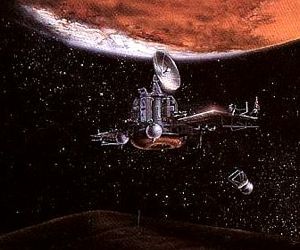 Phobos 1 Credit: NASA |
AKA: 1F;Fobos;Phobos. Status: Operational 1988. First Launch: 1988-07-07. Last Launch: 2011-11-08. Number: 6 . Gross mass: 6,220 kg (13,710 lb).
The mission included co-operation from 14 other nations including Sweden, Switzerland, Austria, France, West Germany, and the United States (who contributed the use of its Deep Space Network for tracking the twin spacecraft). The objectives of the dual mission were to 1) conduct studies of the interplanetary environment, 2) perform observations of the Sun, 3) characterize the plasma environment in the Martian vicinity, 4) conduct surface and atmospheric studies of Mars, and 5) study the surface composition of the Martian satellite Phobos.
In support of these objectives, the mission was to perform the first close scientific investigation of and landing on another planet's moon. In addition to their on-board instrument complement, each vehicle carried a lander designed to land on Phobos' surface and perform a number of in-situ measurements. Phobos 2 also carried a second, smaller "hopper" lander designed to land on Phobos and then use its spring loaded legs to move ("hop") about the moon's surface to make chemical, magnetic and gravity observations at different locations. Phobos 2 operated nominally throughout its cruise and Mars orbital insertion phases, gathering data on the Sun, interplanetary medium, Mars, and Phobos. Phobos 2 entered Mars orbit on January 29, 1989. Contact with the vehicle was lost on March 27, 1989 shortly before the final phase of the mission during which the spacecraft was to approach within 50 meters of Phobos' surface and release its two landers. The cause of the failure was determined to be a malfunction of the on-board computer.
The main section of the spacecraft consisted of a pressurized toroidal electronics section surrounding a modular cylindrical experiment section. Below these were mounted four spherical tanks containing hydrazine for attitude control and, after the main propulsion module was to be jettisoned, orbit adjustment. A total of 28 thrusters (twenty-four 50 N thrusters and four 10 N thrusters) were mounted on the spherical tanks with additional thrusters mounted on the spacecraft body and solar panels. Attitude was maintained through the use of a three-axis control system with pointing maintained with sun and star sensors. Power was generated via solar arrays. The Mars orbit insertion maneuver was performed by a dedicated propulsion module utilizing used nitric acid and an amine-based fuel, with a 9.86-18.89 kN variable thrust chamber and eight helium pressurized aluminum alloy tanks. After achieving the final orbit, the orbit insertion module was jettisoned, exposing the downward viewing instruments on the main structure. Mass was 2600 Kg in Martian orbit (6220 Kg with orbital insertion hardware attached). The computer had 30 Mbit memory storage. Downlink was via a 2 degree-of-freedom parabolic high gain antenna at 4 kbits/sec. The larger Phobos landers would have transmitted data directly to Earth at 4-20 bits/sec on 1.672 Ghz to 70 m Soviet dishes. 'Hopper' lander data would have been relayed via the orbiter.
The payload included a TV imaging system, a thermal infrared spectrometer/radiometer with 1-2 km resolution; a near-infrared imaging spectrometer; a thermal imaging camera; magnetometers; gamma-ray spectrometers; an X-ray telescope; radiation detectors; and radar and laser altimeters. The 'Hopper' lander was designed to make chemical, magnetic and gravity observations at different locations on Phobos' surface. Only carried by Phobos 1 was the Lima-D laser experiment, designed to vaporize material from the Phobos surface for chemical analysis by a mass spectrometer, and an imaging radar. Only carried by Phobos 2 was the 'DAS' platform lander, which carried a panoramic stereo TV system, seismometer, magnetometer, X-ray fluorescence spectrometer, alpha particle scattering device, and penetrator.
NASA NSSDC Master Catalog Description
The Phobos-Grunt spacecraft did not perform its scheduled burn to begin its trajectory to Mars and could not leave Earth orbit. It re-entered Earth's atmosphere on 15 January 2012.
Phobos-Grunt (alternatively Fobos-Grunt) was a Russian mission designed to land on the martian moon Phobos and return a sample to Earth. The primary scientific objective was to analyze the sample on Earth to understand the origin and reconstruct the history of Phobos. Specific objectives were to analyze the composition of the material returned and to determine how it related to other material in the solar system, if it contained any particles ejected from the martian surface, protosolar matter, or organic material, if it had been differentiated and to what degree, and the ages of the sample. A robotic arm would have collected approximately 100 to 200 grams of samples and deposit them in a return capsule which will be launched back to Earth. Phobos-Grunt was launched with a Chinese Mars orbiter mission, Yinghuo-1.
Spacecraft and Subsystems
The lander comprises a short cylindrical body with three landing legs and two solar panel wings. Total dry mass of the lander cruise stage is 730 kg. Instruments, the sample return vehicle, and the robotic arm are mounted on top of the structure. Communications are achieved via the Onboard Radio Complex, which operates in X-band and has a data rate of 16 Kbit/sec. Power is supplied by the solar panels, which have a total area of 10 square meters and provide a maximum power of 150 W for the payload. The cruise stage will carry 870 kg of Unsymmetrical Dimethylhydrazine (UDMH) propellant and will be run by the BKU flight control system. Spacecraft attitude and control are achieved using a star tracker unit (BOKZ-MF), optical sun trackers (OSD), the Baseless Inertial Unit (BIB-FG), and a Television System of Navigation and Observation (TSNN). A radar system, the Dopler Measurer of Velocity and Range (DISD), will be used for final approach and landing on Phobos.
The scientific payload has a total mass of 50 kg. It comprises a number of instruments mounted on the spacecraft to evaluate the regolith at the landing site. These are the FOGS Gamma Spectrometer, the MAL-1 Mass Spectrometer, the Termofob Thermodetector, and the Seismo-1 Seismometer. Phobos-Grunt also carries a Meteor-F cosmic dust detector. The sampling unit consists of a robotic arm, a shifting device, an inlet capsule, and TV cameras for visual control. The area around the lander will be assessed and samples chosen. The robotic arm consists of a cylindrical scoop which can open, with a piston inside to push the samples out into the cylindrical inlet container. A photo-diode will be used to determine if a sample has been deposited. The samples will fall into the interior of the sample return capsule. Samples can be up to 1.3 cm in size.
The return stage is mounted on springs on top of the lander. It has a dry mass of 106.66 kg and a fueled mass of 296 kg. The springs will eject the return stage and propel it to a safe distance above the lander before the rockets ignite, to prevent damage to the instruments on the lander. Power is provided by 1.64 square meters of solar panels. It is also equipped with a star tracker, sun tracker, and inertial unit. The propulsion unit has a thrust of 130.5 N and uses UDMH from a pressure-fed propellant supply system. Attitude control is achieved using 16 small 0.08 kg nitrogen gas thrusters. The craft is spin-stabilized during its flight back to Earth. The reentry capsule has a mass of 7.5 kg.
Mission Profile
Phobos-Grunt launched on 8 November 2011 at 2016 UT on a Zenit 2SB41.1 rocket from the Baikonur Cosmodrome in Kazakhstan into an elliptical Earth orbit. The plan was to use a Fregat upper stage to carry Phobos-Grunt and Yinghuo-1 on an eleven month cruise to Mars. However, the later firings never occured and the spacecraft remained in Earth orbit. It reentered the atmosphere on 15 January, 2012.
The plan for the mission if it had made it to Mars is as follows: It will orbit Mars for a few months and touch down on Phobos in February 2013. Sample assessment and collection will take place over the the next 2 to 7 days. It will collect 15 to 20 separate samples. After the samples have been collected, the springs will propel the return stage away from the lander and the rockets provide the 35 km/hr velocity needed to escape Phobos' gravity. After the necessary maneuvers, the return capsule should arrive at Earth in August of 2014. The lander experiments will continue to operate on the surface for a year.
More at: Fobos 1F.
Family: Mars orbiter. Country: Russia. Engines: KTDU-425A. Launch Vehicles: Mars tactical rocket, Proton, Proton-K/D-2, Zenit-2SB. Projects: Mars. Launch Sites: Baikonur, Baikonur LC200/40, Baikonur LC200/39, Baikonur LC45/1. Agency: IKI, Lavochkin bureau. Bibliography: 118, 2, 274, 279, 296, 6, 67, 12386, 12387.
 | Fobos Hopper 'Hopper' surface probe that was to have been deployed on the surface of Phobos on the Fobos-1/2 missions Credit: Andy Salmon |
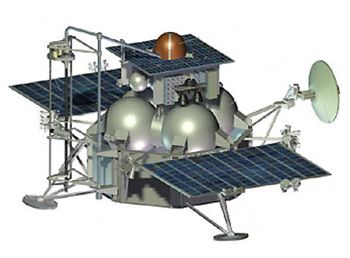 | Fobos-Grunt Credit: Manufacturer Image |
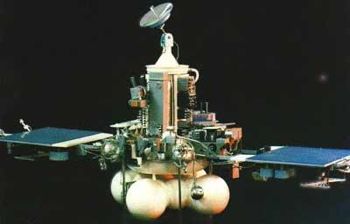 | Phobos 1 Credit: Manufacturer Image |
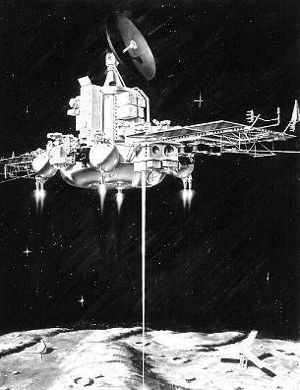 | Fobos |
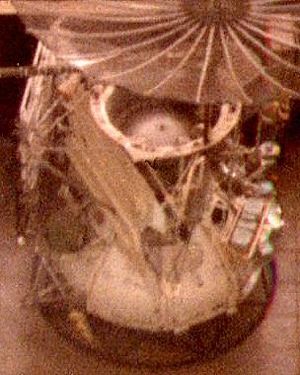 | Venera Bus MAI, March 1994 Credit: © Dietrich Haeseler |
 | Fobos-Grunt Credit: Manufacturer Image |
1988 July 7 - . 17:38 GMT - . Launch Site: Baikonur. Launch Complex: Baikonur LC200/39. LV Family: Proton. Launch Vehicle: Proton-K/D-2.
- Phobos 1 - .
Payload: 1F s/n 101. Mass: 6,220 kg (13,710 lb). Nation: Russia.
Agency: MOM.
Program: Mars.
Class: Mars.
Type: Mars probe. Spacecraft Bus: 5MV.
Spacecraft: Fobos 1F.
USAF Sat Cat: 19281 . COSPAR: 1988-058A. Apogee: 130,504 km (81,091 mi). Perigee: 2,628 km (1,632 mi). Inclination: 50.80 deg. Period: 3,267.73 min.
Second of two missions to Mars' moon Phobos; carried 2 landers; planned to enter Mars orbit. Phobos 1 operated nominally until an expected communications session on 2 September 1988 failed to occur. The failure of controllers to regain contact with the spacecraft was traced to an error in the software uploaded on 29/30 August which had deactivated the attitude thrusters. This resulted in a loss of lock on the Sun, resulting in the spacecraft orienting the solar arrays away from the Sun, thus depleting the batteries. Left in solar Orbit (Heliocentric).
- 1F DPS - . Payload: Dolgozhivushchaya PS. Mass: 6,220 kg (13,710 lb). Nation: Russia. Agency: UNKS. Program: Mars. Spacecraft Bus: 5MV. Spacecraft: Fobos 1F. COSPAR: 1988-058xx.
1988 July 12 - . 17:01 GMT - . Launch Site: Baikonur. Launch Complex: Baikonur LC200/40. LV Family: Proton. Launch Vehicle: Proton-K/D-2.
- Phobos 2 - .
Payload: 1F s/n 102. Mass: 6,220 kg (13,710 lb). Nation: Russia.
Agency: MOM.
Program: Mars.
Class: Mars.
Type: Mars probe. Spacecraft Bus: 5MV.
Spacecraft: Fobos 1F.
USAF Sat Cat: 19287 . COSPAR: 1988-059A. Apogee: 79,750 km (49,550 mi). Perigee: 850 km (520 mi). Inclination: 1.00 deg. Period: 4,590.00 min.
First of two Mars missions to Mars' moon Phobos; carried two landers; entered Mars orbit 1/29/89; failed 3/27/89; extremely limited science data. Phobos 2 operated nominally throughout its cruise and Mars orbital insertion phases, gathering data on the Sun, interplanetary medium, Mars, and Phobos. Shortly before the final phase of the mission, during which the spacecraft was to approach within 50 m of Phobos' surface and release two landers, one a mobile 'hopper', the other a stationary platform, contact with Phobos 2 was lost. The mission ended when the spacecraft signal failed to be successfully reacquired on 27 March 1989. The cause of the failure was determined to be a malfunction of the on-board computer.
- 1F DPS - . Payload: Dolgozhivushchaya PS. Mass: 6,220 kg (13,710 lb). Nation: Russia. Agency: UNKS. Program: Mars. Spacecraft Bus: 5MV. Spacecraft: Fobos 1F. COSPAR: 1988-059xx.
- 1F PPS - . Payload: Prigayushchaya PS. Mass: 6,220 kg (13,710 lb). Nation: Russia. Agency: UNKS. Program: Mars. Spacecraft Bus: 5MV. Spacecraft: Fobos 1F. COSPAR: 1988-059xx.
1989 March 27 - .
- Contact lost with Phobos 2 probe - .
Nation: Russia.
Spacecraft Bus: 5MV.
Spacecraft: Fobos 1F.
Phobos 2 operated nominally throughout its cruise and entered Mars orbit on January 29, 1989. Contact with the vehicle was lost on March 27, 1989 shortly before the final phase of the mission during which the spacecraft was to approach within 50 meters of Phobos' surface and release its two landers. The cause of the failure was determined to be a malfunction of the on-board computer.
2011 November 8 - . 20:16 GMT - . Launch Site: Baikonur. Launch Complex: Baikonur LC45/1. LV Family: Zenit. Launch Vehicle: Zenit-2SB.
- Fobos-Grunt - .
Mass: 13,500 kg (29,700 lb). Nation: Russia.
Class: Mars.
Type: Mars orbiter. Spacecraft Bus: 5MV.
Spacecraft: Fobos 1F.
Decay Date: 2012-01-15 . USAF Sat Cat: 37872 . COSPAR: 2011-065A. Apogee: 274 km (170 mi). Perigee: 199 km (123 mi). Inclination: 51.40 deg. Period: 89.20 min.
Failed soil-return mission to Martian moon Phobos. The main propulsion system, which was to have boosted the probe out of earth parking orbit to trans-Mars insertion, failed to ignite. Attempts to communicate with the spacecraft partially succeeded but it could not be commanded to conduct an engine burn at a later opportunity. Destroyed on reentry into the earth's atmosphere.
Back to top of page
Home - Search - Browse - Alphabetic Index: 0- 1- 2- 3- 4- 5- 6- 7- 8- 9
A- B- C- D- E- F- G- H- I- J- K- L- M- N- O- P- Q- R- S- T- U- V- W- X- Y- Z
© 1997-2019 Mark Wade - Contact
© / Conditions for Use